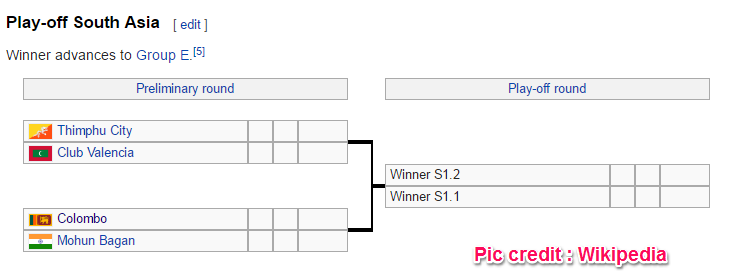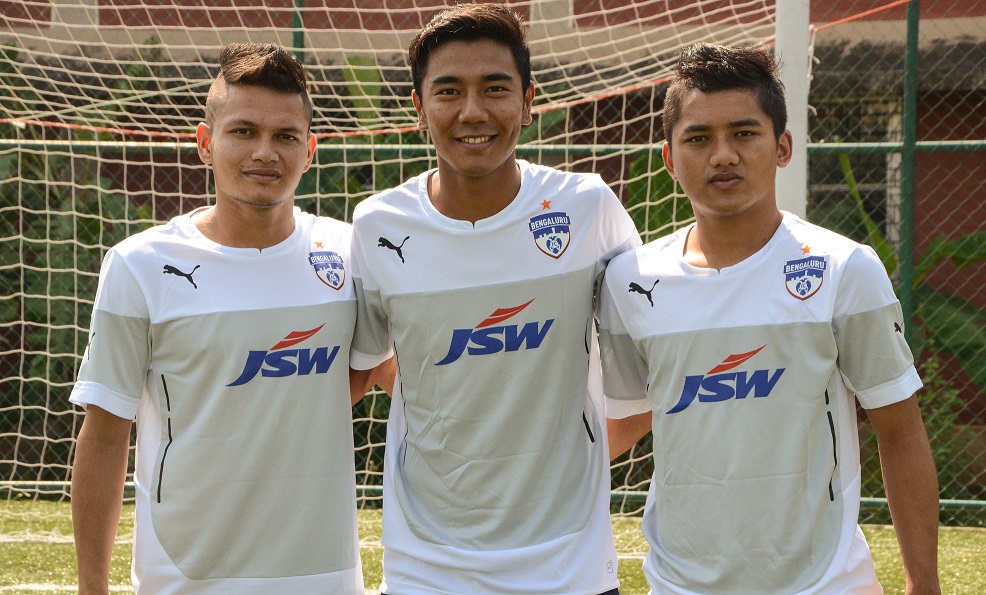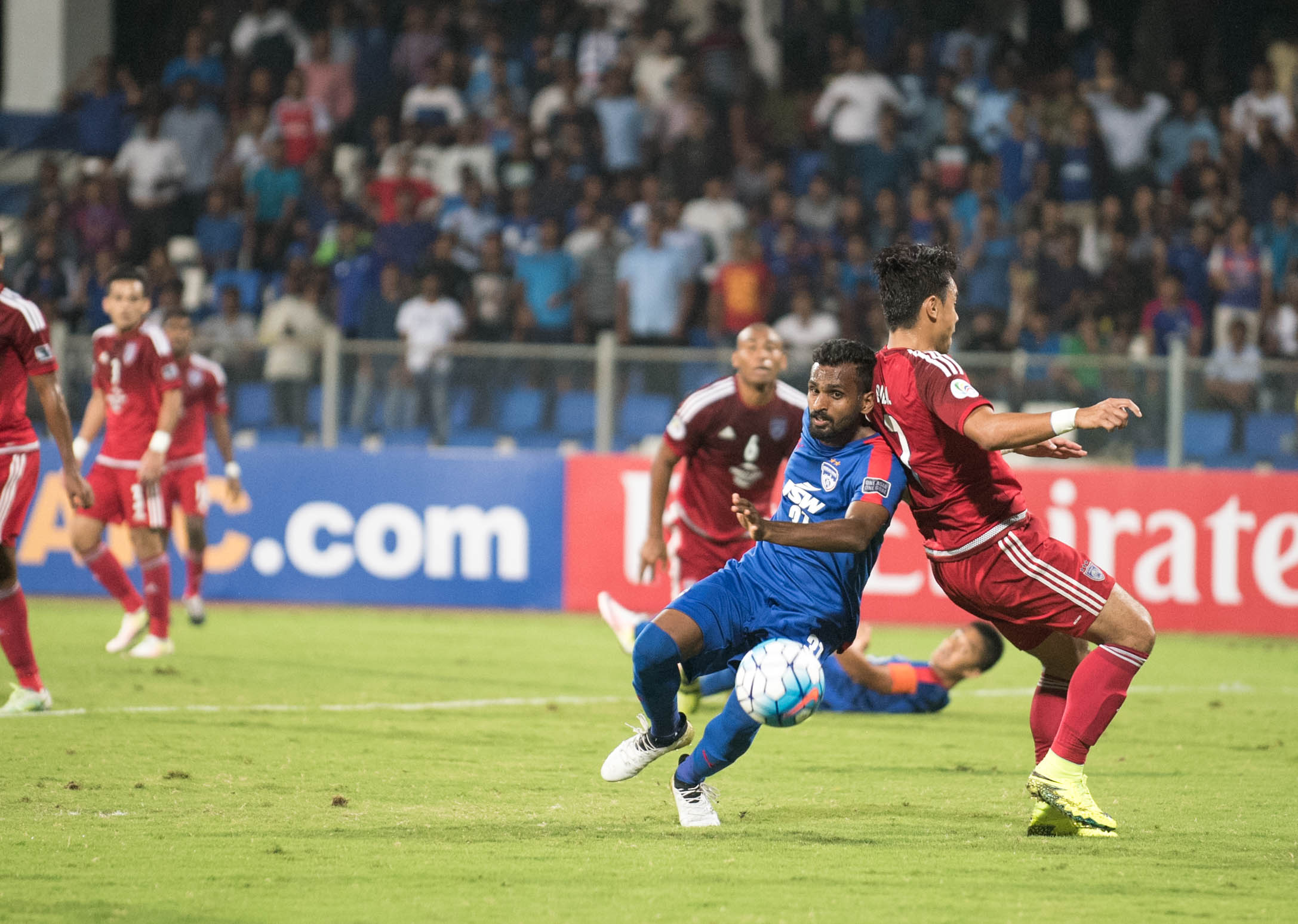
Who wouldn’t get frustrated and who wouldn’t want to rant about the mess that is Indian football. A visibly frustrated Nevin Thomas decided to have a go at it. You can follow him on Twitter here.
The mess that is Indian football
‘A merged league is good for Indian football’, said a very important All India Football Federation official recently. The Indian football players echoed it (because it’s really not in our culture to voice concerns even if there were any). Foreign stars, with very little idea of how football works in India, were saying the same things too. After all, it was just common sense.
BECAUSE:
- Longer league means stability for players. They don’t have to keep jumping clubs every three months.
- Proper rest. They aren’t playing 3 games (2 of which went all the way to penalties) in 7 days.
READ: Steve Coppell’s take on ISL finals
- Going in sync with international leagues will allow smooth transfers of players (IN and OUT).
- We wouldn’t have to call it 2016-17 I-League when it’s actually held only in 2017 (OCD nightmares, you see).
The list, I’m sure, goes on and on. And as for the cons, I can’t think of anything apart from a few marquees (oldies) turning down ISL due to the longer duration of the league. Ok, so a few T-shirts won’t be sold. Who cares?
What is actually bewildering is how the AIFF has thought about all these ONLY after kick-starting a league. See, there was this football league, which in 2007 was rebranded as ‘I-League’, running in the country. Why didn’t AIFF try improving the league instead of starting a new one? Ok, it wasn’t doing so well, with teams pulling out faster than Sunil Chhetri could score goals. But, to be fair to them, they had valid reasons. How do you survive (financially) in a league that gets ZERO promotion? Blimey, I can’t for the life of me remember the last time when I saw ISL-like efforts being put in for what is still India’s gateway to the Asian club championships.
Which is why it was quite exciting (regardless of the ‘seize the means of production’ T-shirts I wear) to see money-minded IMG-Reliance (International Management Group-Reliance Industries Limited) buying out AIFF’s commercial rights in 2010.
But things didn’t exactly as some of us had hoped. The new-comer continued the trend of not giving a duck about I-League and then launched a completely different league — a shorter, IPL-style (thankfully, with no cheerleader nonsense) Indian Super League.
I know it has been three seasons now, but I am yet to figure out why there was a need to split Indian football into two, when there was already an existing league that complied to all the AFC rules. If you had the money and the PR machinery to start a new league with a BANG, why wasn’t it utilised to boost the existing model?
So I decided to ask around through a poll on Twitter and here are some of the reasons I got:
1) Better packaging: A lot of people said the ISL made football in India way more ‘watchable’. In other words, it was better packaged for the Indian audience. 7 pm kick-off was ideal for office-goers as compared to the 4pm matches of I-League. Star Sports was doing a better job than Ten Sports in broadcast – better commentary, better camera angles, better pundits… basically better everything.
2) I-League’s failure: Years of lacklustre performances and mismanagement had given I-League such a bad name that it made more sense to start something fresh. If I was a sponsor, I would want to invest in something new (especially with the financial backing of IMG-Reliance) than a stale I-Leauge.
3) Moving away from family set-up: Indian football clubs have been traditionally run by wealthy families. With no self-sustaining mechanism in place for these clubs, AIFF thought it was better to encourage more corporate-sponsored teams. In short, ISL was an attempt to kill the likes of Salgaocar FC and encourage more Bengaluru FCs.
Barring point number two, all the other reasons I was told on my poll in Twitter, did not involve the need to start a new league though. Add eight new corporate sponsored (with solid financial backing) clubs to I-League and the pressure would have pushed family-run clubs to either pull out OR up their game, right? And, how difficult would it have been to have late kick-offs to make I-League more TV friendly?
We surely have enough stadiums.
READ Joy Battacharjya’s piece on stadium utilisation
And I’m sure TV guys would have been more than OK with broadcasting the game at 7 pm instead of 4 pm.
ESPN senior assistant editor Debayan Sen’s tweet sums the Indian football scenes the best up. IMG-Reliance wanted something completely in its control and AIFF happily gave a thumbs-up signal. Which would have been OK, had all stakeholders been consulted. But were they?
Ever since the takeover, though, the agenda of AIFF seems to be somehow move away from the existing football big-guns. More corporate backed teams, less family-run clubs. The idea, as told to me by AIFF VP Subrata Dutta in an interview, is to ensure all clubs have a sustainable model for revenue generation. The baffling fact is how AIFF decided that family-run clubs cannot find a model but corporate-run teams can. Apart from BFC, no corporate-run club has scaled the zenith of Indian football. It is fair to say, ISL was a big nail in the coffin for all the I-League clubs which were already in scarcity of funds. The sponsors had something better to invest in and the likes of Royal Wahingdoh (exciting team from Shillong), and the Goan clubs, including Dempo SC (one of the most successful team in history of Indian football league), cut their ties with the I-League. Another theory is that a new league was always in the plans for IMG-R but Bengaluru FC’s phenomenal success caused the sudden plunge. BFC showed there is a clear way of succeeding in Indian football, a model other clubs soon tried to emulate, and the rising popularity of the I-League created concerns for the team at IMG-R plotting a new league.
Now, three seasons into the so-called football revolution, AIFF wants a League merger — for the better of football, it claims. But, like the idea of ISL, was this merger idea fast-forwarded due to BFC’s success in the Asian arena? It would look funny to the outside world that the league with the likes for Forlan and Malouda playing is not the one representing India in Asia. And I’m sure, BFC’s success has got the think-tanks at IMG-R and ISL teams licking their lips at the idea of more lucrative sponsorship deals.
But there are some problems with the merger plans. AIFF has agreed a deal with these ISL clubs that guarantees them no relegation for around eight seasons. So the top league, after the merger, will have teams playing without any relegation. The second tier league, which will be today’s I-League, what AFC recognises as India’s football league, will have no scope of promotion into the new top league, though, relegation still remains.
Basically, all the clubs who have traditionally existed, including big guns such as Mohun Bagan and East Bengal, now face the threat of not playing in the top league. While they can still compete in the second tier league, it remains highly unlikely that they will, considering the difficulty it will face in attracting potential sponsors with no titles to win or AFC competitions to take part.
Is it even fair to these teams who have done so much for Indian football? “We haven’t made any decision on which teams get to play top league and which don’t,” said an AIFF big shot when I asked. “After Under-17 world cup, the new league will start,” said another AIFF biggie, recently in a press conference. So when will we ever get a confirmation on who will play where? Less than a year to go before the big shake-up and teams do not even know where they will be playing. So how can they sign a good quality player for a long term deal?

The Goan clubs have already left due to the proposed new roadmap for Indian football. Last year the likes of Royal Wahindoh and Pune FC cited the very same reasons for their exit, though AIFF stuck to its stance that these clubs failed to reach the financial criteria required to play in the top division.
Yet, barring BFC, the corporates have struggled to make the cut too. If Bharat FC had done enough to fulfill the criteria, then why did they pull out after a brief period?
Story made short — IMG-R walked into Indian football and did whatever it wanted to.
Nobody knows how many teams from the I-League will make it to the top-division. Nobody knows what the criteria will be. Will Kolkata have Bagan, East Bengal and ATK when many states won’t even have one team?
There hasn’t been a shortage of excuses though. One phrase given by most AIFF officials in their twisted justification is — ‘many clubs don’t fulfill the AFC requirements’. Apparently many Indian clubs do not have (financially and infrastructure-wise, I assume) to have an AFC club license. So why were they given the rights in the first place? And are we to assume every club that started atleast in the I-League era will fulfill these criteria?
In a way, AIFF is suggesting that only clubs fulfilling the set of rules will have a chance of making it to the top league after the proposed merger.
So I downloaded the 70-page-long AFC club licensing criteria for 2016 and went through it to find out what these possible reasons could be (the OCD kicked in)
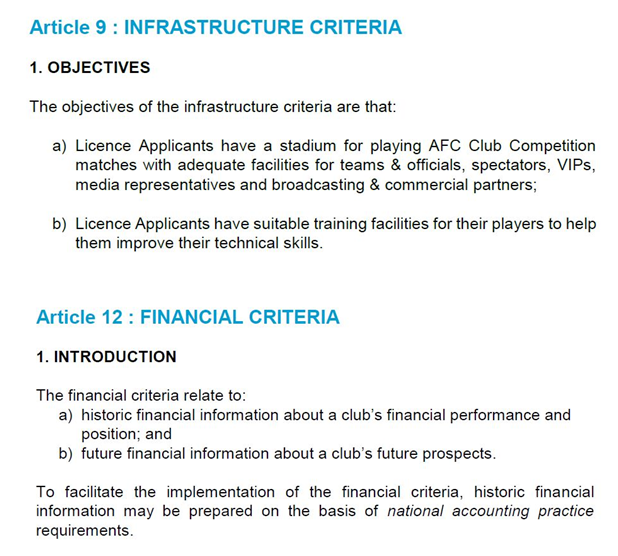 To be honest, while the I-League clubs seem to be safe on the infrastructure demands, the financial part is slightly murky, with AFC wanting historic and future information. Clubs such has Salgaocar, which has relied on family wealth, might struggle to produce the required financial documents. Or so I think (I would love to be wrong).
To be honest, while the I-League clubs seem to be safe on the infrastructure demands, the financial part is slightly murky, with AFC wanting historic and future information. Clubs such has Salgaocar, which has relied on family wealth, might struggle to produce the required financial documents. Or so I think (I would love to be wrong).
Scroll reported that Salgaocar had failed to participate in the licensing process.
But one is to assume most clubs will be able to produce the required documents, considering how the likes of East Bengal and Mohun Bagan play in the AFC tournaments most seasons.
And mind you, while AIFF will not openly admit it, it’s the ISL clubs who will struggle a lot more to match the AFC criteria. For example the foreign player rule:
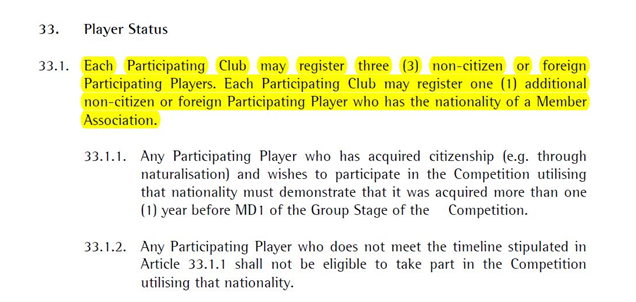
It doesnt mean the ISL clubs can’t take part. But they will have a lot of foreign players who won’t be allowed to play, which is an unnecessary burden on team wages. Will the foreign stars in the team be OK with missing out on Asia’s top league? Also, barring Goa, which other team has player with 3 foreign players or lesser, and succeeded in ISL?
The great Indian football league merger, at least according to me, should be delayed till ISL teams have more Indians playing. And once that is achieved, it can merge into I-League as one big, fat league (with around 16 teams) and we can thereafter replicate the 9-month league format that most countries have. Rather than rush to a merger, push ISL teams to field more Indians, allow I-league to grow simultaneously, at least organically, if you do not want to promote it (AIFF has admitted that I-League TV viewership and stadium turn-out has increased every year), and in two years time, come up with a structure that benefits all stakeholders of Indian football. (Unified league in India likely after U-17 World Cup – Kushal Das)
But, my brain tells me AIFF and IMG-R won’t wait that long. Actually, AIFF Gen. Sec said it too.
If Oxford dictionary’s definition of ‘stockholm syndrome’ as “Feelings of trust or affection felt in many cases of kidnapping or hostage-taking by a victim towards a captor” is something to go by, then it perfectly describes the relationship between AIFF and IMG-Reliance. The Indian football federation seems to have completely lost the plot, and now, in its bid to survive, has developed an unjustifiable affection for IMG-R.
One can only be an Andy Dufresne (that’s your cue to watch Shawshank Redemption if you haven’t yet) and HOPE the merger will not mark the end of a legacy in Indian football.
This blog post is just a rant and it has nothing to do with my employers. In fact, I have a feeling they won’t like me so much after this. But, blah! As usual, I’m likely to make mistakes. I urge you to correct me wherever you think I’ve gone wrong..
Downloads:
You can download the AFC club licensing criteria here (page 33 infrastructure, page 55 financial): http://www.the-afc.com/uploads/afc/files/AFC_CLR_Booklet_2016.pdf
AFC Champions League competition regulations: http://www.the-afc.com/uploads/afc/files/acl_2015_competition_regulations_final.pdf
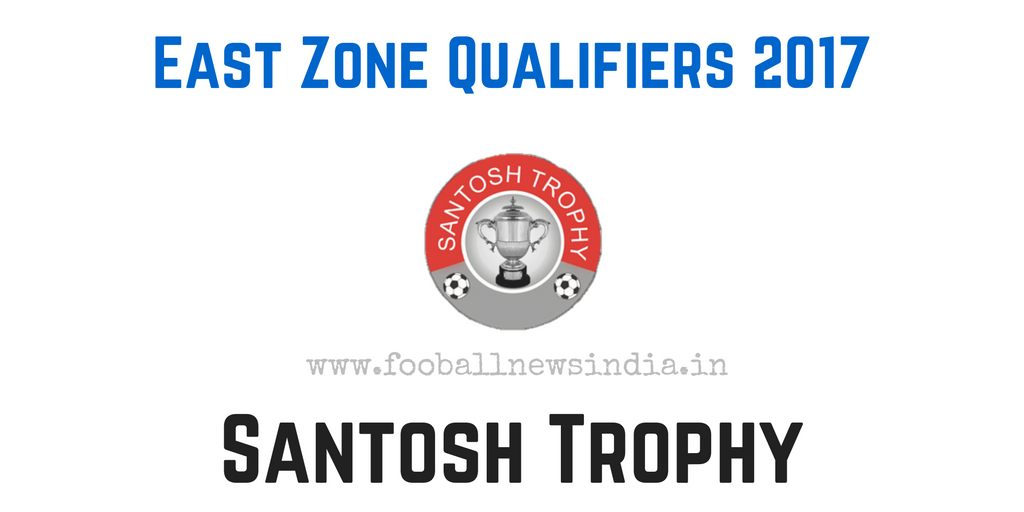 East Zone qualifiers for Santosh Trophy 2016 was held in Jharkhand. Teams in the East zone are divided into two groups.
East Zone qualifiers for Santosh Trophy 2016 was held in Jharkhand. Teams in the East zone are divided into two groups.





